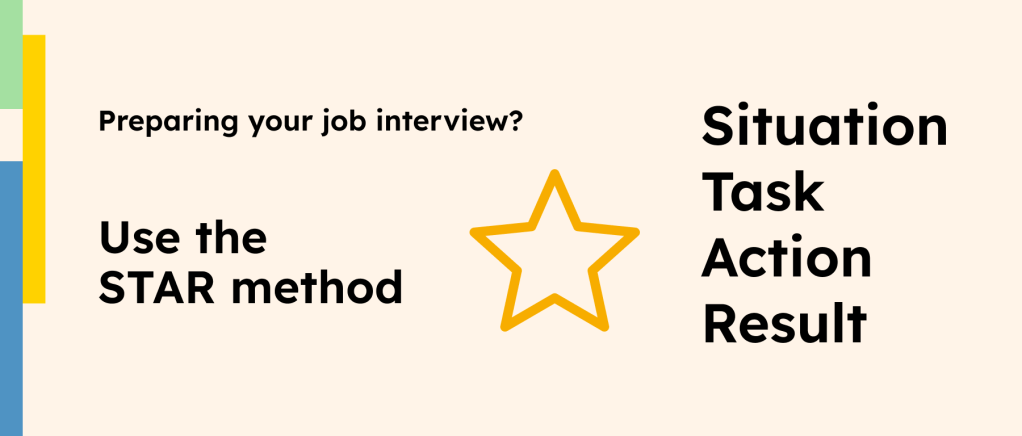As a newcomer to Canada, getting to the interview stage in your job search after weeks or months of networking, reviewing job listings, and submitting resumes can be exciting. Now, you’re much closer to landing the job you want, but there are still a few crucial steps left.
To ensure you put your best foot forward during the interview and maximize your odds of getting a job offer, it’s imperative that you prepare well for your interview. The STAR interview method is effective in conveying the information Canadian recruiters look for in candidates and can help you frame responses to interview questions in a clear, concise, and confident manner. In this article, we describe what the STAR method is, when and how to use it in an interview, and provide useful examples to get you started with your interview preparation.
In this article:
- What is the STAR method?
- Advantages of using the STAR method in job interviews
- What type of interview questions is the STAR method used for?
- How to use the STAR method to answer interview questions
- How to prepare for STAR interview questions
- Tips on using the STAR method to ace your interview
What is the STAR method?
The STAR method is a job interview technique that helps you structure responses clearly and succinctly in a storytelling format. It neatly packages each response in a compelling way using personal examples to showcase your skills, professional experience, and qualifications. People find stories more memorable than simple explanations or sharing of facts, so using a storytelling approach helps keep your interviewers engaged and increases the odds that they’ll remember you (and your responses) in a positive light.

STAR is an acronym that stands for:
- Situation: The context or background that sets the scene for your example. It could relate to a previous full-time or part-time job, volunteer work, your studies, internships, or even your personal life.
- Task: A description of your responsibility or objective in the situation.
- Action: The steps or action you took to fulfill your responsibility or achieve your objective.
- Result: The outcome of your actions, as well as what you accomplished and learned from the experience—even if the result wasn’t favourable.
There are a few variations of the STAR method, including STARS (situation, task, action, result, skills) or START (situation, task, action, result, takeaway) or CAR (context/challenge, action, result).
Advantages of using the STAR method in job interviews
The STAR method makes it easier to prepare for a job interview and excel in it. Some of the main benefits of using the STAR method include:
- Ensures your response is focused: The STAR format ensures that you address a behavioural question in a concise manner while still covering all the essential elements needed for a complete response. Using a real-life example, you can craft a response that touches on all the crucial aspects that interviewers are interested in, including:
- what you did,
- the skills you applied,
- and the outcome you achieved.
- Makes answers compelling: Everyone enjoys hearing stories. The STAR method uses a storytelling format which makes your answers engaging and memorable for interviewers.
- Provides a consistent structure: Regardless of the behavioural question asked, the structure remains the same, calling attention to the skills and qualities you feel are most important for the job. The consistent format can also make it easier to remember your prepared answers, as well as come up with strong responses on-the-spot during interviews.
- Helps you prepare for interviews effectively: The simple four-step STAR approach makes it easier to craft and rehearse answers to possible interview questions. Once you come up with the best real-life example to use in a particular situation, crafting a quality response can be done easily.
- Helps keep your answers brief and succinct: Sometimes when we are nervous during interviews, we can ramble, as it’s tempting to fill in silence with more talking. Not only is this distracting for the interviewer, but it can also take their attention away from the important aspects of your response. The STAR method, however, helps you provide answers that have a clear structure and conclusion to prevent you from talking unnecessarily.
What type of interview questions is the STAR method used for?
The STAR method is used to answer behavioural questions, which are commonly asked during interviews. They are designed to ask about your past actions in a certain situation.
Some common behavioural questions asked in Canadian interviews are:
- Describe a time you failed at something and how you handled it.
- Give me an example of a situation where you had a conflict with someone.
- What is your proudest accomplishment?
- Tell me about a time you had to manage multiple conflicting priorities.
- Give me an example of a time you showed initiative.
- How do you handle pressure at work?
- Tell us about a time where you had to deal with circumstances outside of your control
Behavioural questions differ from situational questions, which are typically about how you would act in an hypothetical, future situation.
How to use the STAR method to answer interview questions
Although the idea of coming up with real life examples for every question may seem daunting, the STAR method is quite simple once you get used to it. Your entire response should be no longer than two to three minutes, so keep that in mind while practicing. Here’s how it all comes together:
Question: Give me an example of a time you showed initiative.
Situation
In one or two sentences, set the scene for your story. Describe the situation with a little bit of background so the interviewer understands the context of the example you’re about to share. Don’t provide too much detail—get to the point quickly. As a newcomer to Canada, you may have little or no Canadian experience yet, but you can use examples from jobs in your home country, part-time or volunteer work in Canada, or even from your studies or internships.
Example:
In my previous role, I worked as a content specialist for a tech start-up that developed apps for small businesses. Although the company was doing well, I noticed that they weren’t using social media consistently and to its full potential.
Task
Describe your task—whether it was allocated to you or you took the initiative—in one or two sentences.
Example:
Before discussing this with the marketing manager, I did some research on how our competitors were using social media, platforms on which they were present, and what they posted. I then presented my case to my supervisor and offered to take on the task of managing the company’s social media channels to help drive traffic to their website and increase their followers.
Action
Showcase what you did to fulfill the task, including the skills you used to achieve your goal.
Example:
I devised a well thought out social media plan that outlined the company’s brand and target audience, then researched social media scheduling apps and selected the best one for the company based on price and usage requirements. I then set up a weekly publishing schedule that included our blog posts, app design tips, testimonials from existing clients, as well as behind-the-scenes photos from the office.
Result
Highlight how you created a positive impact and, where possible, provide measurable results.
Example:
Within six months, the company’s followers increased by 25 per cent on Instagram and 20 per cent on LinkedIn and we were getting regular comments and shares. Almost 10 per cent of our website traffic came through social media, up from almost zero. My supervisor was so happy with my work that I was officially put in-charge of social media and, at the end of the year, I was promoted to a Content and Social Media Manager role.
Here are some additional examples of STAR responses:
Describe a time you failed at something and how you handled it.
To me, failure is when you stop trying. Early in my career, when I was working as a sales associate, our company rolled out new KPIs, which resulted in an aggressive 50 per cent increase in my quarterly targets. The increase seemed so monumental, that I couldn’t think of anything that would work. And so, I continued doing exactly what I was doing before.
One month into the new quarter, my boss asked me if I was on-track to meet the new targets and I said no, I couldn’t think of anything that would increase our numbers by 50 per cent. Then, he asked me if I could think of five things that might increase our sales by 10 per cent, and I immediately realized the mistake I had made. I requested a few hours’ time to chart out some ideas, and before the end of the day, I had presented seven ideas that could increase my sales by 10 to 15 per cent each.
Because of the month I had already wasted, I was only able to achieve a 38 per cent increase in sales that quarter, but the following quarter, I was the best performer among all the sales associates. Since then, I always make it a point to break a problem down into easily manageable parts, so they seem achievable not intimidating.
Give me an example of a situation in which you had a conflict with someone.
In my previous role, I worked as a creative designer at a boutique agency. The account manager who managed two of the five clients I supported regularly gave the clients unrealistic timelines without consulting with me. This created friction between all parties involved – me, the account manager, and the clients. Things escalated to the point where one client was furious and threatening to find a new agency, and the account manager blamed me for delays.
I knew the only way to fix this situation was through clear communication. I requested a meeting with the account manager in question, and in an organized, polite manner explained that I had not two but five clients, and realistically, I could spend an average of eight hours per client each week. I then went on to explain how much time different types of design tasks took. The account manager hadn’t thought of my schedule this way, and apologized for setting overenthusiastic timelines with the clients without involving me.
With that resolved, we still had to figure out how to handle the unhappy client and get their tasks done within the agreed upon timeline. I called the two other account managers who handled my three remaining clients to join the meeting, explained the time-sensitivity of the unhappy client’s work and asked if any of the other clients might agree to a deadline extension. Eventually, we found one client who did not mind a two-week delay in their design project, and I used that extra time to meet the timelines we had promised our other client.
After that incident, all three account managers kept me in the loop while setting timelines for client projects. A few months later, the agency hired a design associate to support me with repetitive tasks, so we could offer our clients faster turnaround times on creative work.
How to prepare for STAR interview questions
As a newcomer, you should have a good idea of what common interview questions may be asked in Canada and have responses planned for each of them. Thanks to its consistent structure, the STAR method can help simplify your interview preparation. Here are some useful tips to help you prepare answers using the STAR method.
Identify what qualifications the employer is looking for
Review the job description of the role you’re interviewing for. What are the skills listed? What experience is the employer looking for? What personality traits are most important? You can also expand your research by reviewing similar roles to clarify most sought-after skills. Make a list based on your findings.
Leverage your network for your research
Depending on how much time you have before your interview, you can reach out to professionals working in the company you’re interviewing with. Set up coffee chats to learn about company culture, the skills the employer looks for in candidates, and even tips on the types of questions you might be asked during the interview. For newcomers who’re just starting their career in Canada, job fairs where employers are actively recruiting for entry-level positions are a great platform to meet hiring teams and get insights on the company culture and recruitment processes.
Make a list of your skills
Now that you’re clear on what the employer is looking for, make a list of your skills that align with the job description. For each skill you write down, make a note of situations in which you exhibited it. Don’t worry about the details at this stage, as you can expand on each skill when you craft your STAR responses later.
List your accomplishments
It’s not always easy to come up with compelling examples of how you put your skills to work. Another way to approach this is to brainstorm your accomplishments. Think about how you achieved them and why they’re noteworthy. Then reflect on the skills you used and see which ones match with the skills you identified for the job. These are the ones you want to focus on for the interview.
Write out complete STAR answers for common questions
While you can never predict what questions will be asked in each interview, there are common questions you should prepare for. For each behavioural question you’ve come up with, write out a complete answer using the STAR method. Often, you’ll find you can repurpose some examples for a different question. For example, your response to how you managed a conflict at work could also be used to answer a question on how you handled a difficult situation. That said, it’s good to have multiple examples planned, just in case you’re asked both questions.
Rehearse your STAR responses
Practice makes perfect. Get comfortable with the STAR structure and learn to stop talking once you’ve finished the answer. STAR responses are structured to have a beginning, middle, and end and the interviewer will appreciate your succinct responses. Try to visualize yourself in each situation you describe, rather than memorize. Your responses may not come out exactly as you prepared them, and that’s okay. You want to come across as authentic—not overly rehearsed. Refrain from embellishing or twisting the truth. Trust that your own experiences are strong enough to prove your candidacy.
Do a post-interview assessment
You’ll likely feel tremendous relief once the interview is over. But before you rush off to do something else, make a note of any questions that you struggled to answer. This is easy to do after a virtual interview since you’re already in front of your computer. For in-person interviews, consider making notes on your phone or in a notebook after you leave the workplace while it’s still fresh in your mind. You can then refer to the notes to address these gaps for future interviews.
Tips on using the STAR method to ace your interview
Here are some useful tips that you can put to use immediately to begin using the STAR method with confidence:
Use authentic examples
Always stick to real-life examples with positive outcomes when responding in a STAR format. There are times when it’s okay to use an example with a negative outcome, as long as you conclude the story with what you learned from the experience and how it positively impacted you. Avoid embellishing or stretching the truth to make your story more impressive. If the recruiter asks follow-up questions, you’ll struggle to respond if you’re not being truthful.
Make sure your examples are relevant
Whether you’re preparing answers in advance, or responding to an unplanned question during an interview, make sure you use examples that are relevant to the question and the job. Your example can be taken from previous full-time or part-time jobs, volunteer experience, school, or even your personal life—as long as it exhibits the relevant qualities. For most people, it’s easier to come up with the perfect example when you’re at home preparing for your interview, which is why the more scenarios you brainstorm in advance, the better equipped you’ll be to answer behavioural questions on the spot.
Keep the situation brief
One of the benefits of using the STAR method is that it creates succinct answers. Each response should take two to three minutes, in total. So, keep the situation or context part of your answer very brief, leaving more time to expand on the action and result.
Highlight your accomplishments with data
Use every opportunity you can to explain what you accomplished using hard data. This helps quantify your impact, and makes your story more persuasive for the interviewers. For example, “My updates to the website reduced the loading time of the home page by 50 per cent and reduced the bounce rate by 15 per cent,” is better than “My updates to the website sped up the loading time of the home page so that visitors stayed on the site longer.”
Use “I” instead of “we”
An interview is not the time to be humble, so get comfortable using “I”, rather than “we”, when describing your actions and accomplishments. If you’re describing scenarios in which you were part of a team, try to find a way to narrow in on your role. For example, “I performed the market research to design an app that offers travel discounts to students on a gap year,” is better than “We built an app that offers travel discounts to students on a gap year.”
Avoid sharing confidential information
In your responses, it’s best to be cautious when talking about other companies’ work. Most companies appreciate confidentiality, and may view it as a red flag when a candidate openly discusses client work. When in doubt, use generic language, such as “a client” or a general description such as “a financial institution” rather than the company or brand name when discussing potentially confidential projects. (A general description may also be more effective when you’re citing examples of a brand from your home country that Canadian interviewers may be unfamiliar with.) Use your discretion. At other times, and when you are certain it’s appropriate, describing reputable brands you’ve worked on will be highly regarded by interviewers.
Keep it conversational
During an interview, you don’t want to sound too rehearsed. Not only does this make it harder for you to prepare (because you need to memorize your responses), it can come across as awkward and inauthentic. Try to get your points across in a conversational way. This is one of the balancing acts of job interviews—not too formal, but not too casual, either.
As a newcomer, preparing for your first job interview in Canada can be stressful. The STAR method is an effective formula that ensures that your responses to behavioural questions during interviews have a clear context, action, and results. This approach can be helpful when you’re trying to prepare interview responses that are to the point but also complete in every respect. Be sure to come up with real-life examples to commonly asked questions beforehand, so you feel well prepared as you enter the interview.






